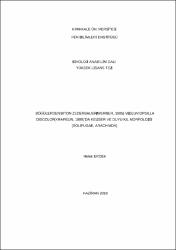| dc.contributor.advisor | Yiğit, Nazife | |
| dc.contributor.author | Erdek, Melek | |
| dc.date.accessioned | 2021-01-16T19:12:33Z | |
| dc.date.available | 2021-01-16T19:12:33Z | |
| dc.date.issued | 2010 | |
| dc.identifier.uri | | |
| dc.identifier.uri | https://hdl.handle.net/20.500.12587/16921 | |
| dc.description | YÖK Tez ID: 258957 | en_US |
| dc.description.abstract | Böğülerin (ARACHNIDA: SOLIFUGAE) sınıflandırılmasında morfolojik karakterler önemli yer tutmaktadır. Tür teşhisinde önem arz eden sistematik ve taksonomik karakterlerin tanımlanması için mikroskobik çalışmalara ihtiyaç duyulmaktadır. Bu çalışmada, böğüleri diğer araknidlerden ayıran ve sınıflandırmalarında önemli morfolojik karakterler olan keliser, pedipalp, malleolus (raket organ) yapıları ve bunlara ek olarak I. bacak, IV. bacak ve rostrum yapıları iki ayrı türde ele alınmış, bunların detaylı morfolojileri tanımlanmıştır.Keliserlerin genel yapısı, üzerinde yer alan flagellum ve duyusal kıl yapılarının morfolojileri ve de bunların olası fonksiyonları incelenmiştir. Her bir pedipalp ve tarsusunun distal ucunda yer alan tutunma organının morfolojisi ve mekanoreseptör olarak işlevi araştırılmıştır. Böğülere özgü olan malleolus (raket organ) üzerindeki duyusal yapılar ve bunların mekanoreseptör ve kemoreseptör işlevleri incelenmiştir.Bu çalışmada Daesiidae familyasına ait Biton zederbaueri (Werner, 1905) ve Gluviopsilla discolor (Kraepelin, 1899) türlerinin keliser ve duyu kıl morfolojileri stereo mikroskop ve taramalı elektron mikroskop (SEM) kullanılarak çalışılmış ve tür teşhisinde önemli olan yapıların taksonomik detayları ortaya çıkarılmıştır. | en_US |
| dc.description.abstract | The classification of solifuges (SOLIFUGAE: ARACHNIDA) is done via important morphological characters. The systematic and taxonomic characters, which are important to diagnose species, need to describe electron microscopic studies. In this study, we focused on the chelicerae, pedipalp, and malleolus (racquet organ) in addition to these 1st legs, 4th legs and rostrum morphology and we described in detail morphology these structures on the two different species.The general structures of chelicerae, the morphology of flagellum and sense hairs on the chelicerae and their probable functions are emphasized. Although their functions are not known in full, it is thought to function as a sensory receptor.The function and the morphology of suctorial organ at the tip of the distal tarsus of each palp as a mechanoreceptor were researched. The sensory structures on the malleolus which is specific for solifuges and functions of these structures as mechanoreceptors and chemoreceptor were investigated.In this study the detailed morphology of chelicerae and sense hairs in solifuges; Biton zederbaueri (Werner, 1905) and Gluviopsilla discolor (Kraepelin, 1899) belonging to Desiidae family were studied using with stereo microscope and scanning electron microscope (SEM) and taxonomic details of the structures, which are important for diagnose of species, were revealed. | en_US |
| dc.language.iso | tur | en_US |
| dc.publisher | Kırıkkale Üniversitesi | en_US |
| dc.rights | info:eu-repo/semantics/openAccess | en_US |
| dc.subject | Biyoloji | en_US |
| dc.subject | Biology ; Zooloji | en_US |
| dc.subject | Zoology | en_US |
| dc.subject | | en_US |
| dc.subject | | en_US |
| dc.subject | | en_US |
| dc.subject | | en_US |
| dc.subject | | en_US |
| dc.subject | | en_US |
| dc.subject | | en_US |
| dc.title | Böğülerden Biton zederbaueri (Werner, 1905) ve Gluviopsilla discolor (Krapelin, 1899)'da Keliser ve duyu kıl morfolojisi (Solifugae, Arachnida) | en_US |
| dc.title.alternative | The morphology of Chelicerae and Sense Hairs in Biton zederbaueri (Werner, 1905) and Gluviopsilla discolor (Krapelin, 1899) in Solifuges | en_US |
| dc.type | masterThesis | en_US |
| dc.contributor.department | KKÜ, Fen Bilimleri Enstitüsü, Biyoloji Anabilim Dalı | en_US |
| dc.identifier.startpage | 1 | en_US |
| dc.identifier.endpage | 125 | en_US |
| dc.relation.publicationcategory | Tez | en_US |
















